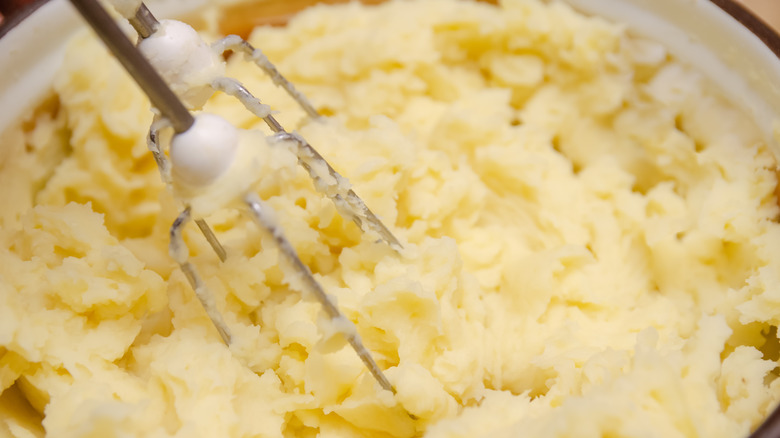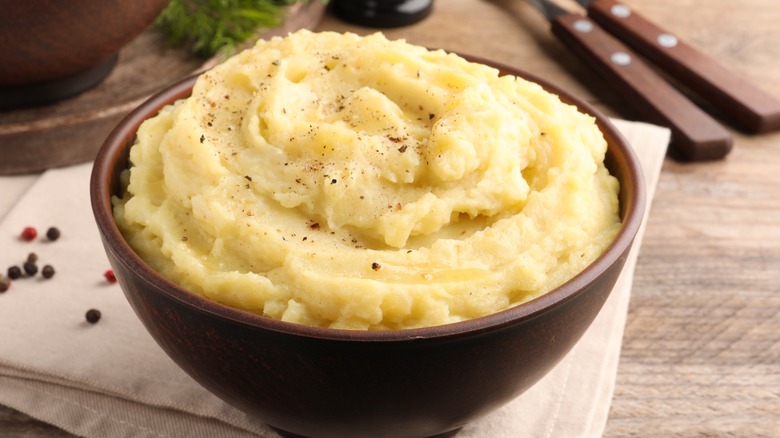The Secret To Martha Stewart's Childhood Favorite Mashed Potatoes
Martha Stewart's mother, Mrs. Martha Kostyra, was a frequent guest star on the "Martha Stewart Living Show." Known as "Big Martha" to differentiate the duo who shared the same first name, she often appeared alongside her daughter to make Stewart's favorite childhood recipes. Mrs. Kostyra died in 2007 at 93, but her classic Polish recipes for pierogi, stuffed cabbage, kielbasa, and comfort foods like mashed potatoes are still treasured by Stewart.
Mashed potatoes are commonly made with butter and milk, but the recipe Stewart remembers from her childhood is a bit different. The mashed potatoes she grew up eating, a recipe shared on her website, rely on another rich dairy product: cream cheese. The potatoes are whipped with whole milk, butter, and heavy cream, much like a traditional recipe, but Stewart adds softened cream cheese for richness and a hint of tang that can't be duplicated with butter or cream.
Some cooks add sour cream to mashed potatoes for tanginess, but as she revealed at the Food & Wine Classic in Aspen in 2021, Stewart prefers cream cheese for its sweetness. "You could incorporate sour cream, but cream cheese is a little sweeter and makes it so unctuous," she told the outlet about her mash recipe. "I can't resist them." Stewart's childhood recipe is still her favorite way to make mashed potatoes today.
Martha Stewart's tips for mashed potatoes
Great mashed potatoes start with boiling the best kind of potatoes. Stewart prefers Yukon Golds for a good reason. These thin-skinned, yellow potatoes are naturally creamy and won't soak up too much water, especially if you boil them whole like Stewart does. White potatoes, like russets, can be used if that's what you have in the pantry, but Yukon Golds end up creamier and richer.
As for the cream cheese addition, bring the cheese to room temperature as the potatoes cook, then heat the milk, butter, and cream in a separate pan. For creamy mashed potatoes, you'll need 8 ounces of softened cream cheese for 3 ½ pounds of Yukon Gold potatoes. Once the potatoes are knife-tender, you'll want to dry them off before mashing. After draining, place them back into the hot pot to let the residual heat evaporate any moisture. This is especially important if you peeled and cut the potatoes before boiling. If you prefer that method, avoid cutting the potatoes into tiny pieces that will absorb too much water and fall apart while cooking.
To prevent gummy potatoes, avoid overmixing. This is one of the most common mashed potato mistakes, so use a light hand when mashing. It helps to thoroughly mix the dairy ingredients together before whipping the potatoes, so you don't have to stir the mash as much. It's even easier if you beat the potatoes and other ingredients in a stand mixer or with a hand mixer until combined.
Preparing mashed potatoes in advance
One of the greatest things about Martha Stewart's mashed potatoes is that they can be prepared in advance for your dinner party, so you aren't stuck in the kitchen boiling potatoes while your guests enjoy cocktails. Once you've made the potatoes a few hours ahead of your party, keep them warm and ready for serving by using a double boiler. Add them to a glass or metal bowl set over a pan of simmering water and cover the bowl. This will gently heat the potatoes until you're ready to serve them. Avoid letting the bottom of the bowl touch the water, and give the mash a good stir before serving.
To prepare the potatoes even further in advance, store them in an airtight container in the fridge for up to three days. Remove the potatoes from the refrigerator 30 minutes to bring them to room temperature. Follow the same directions above, gently heating the mash over simmering water until warmed through. If the potatoes seem dry, add additional milk and butter to loosen them, but remember to warm up your dairy first. Alternatively, stock or broth can be used if you don't want to add more dairy. Even if the potatoes were perfectly seasoned when you prepared them, don't be surprised if they require additional salt and pepper at this point. Give them a taste before serving and season appropriately.



